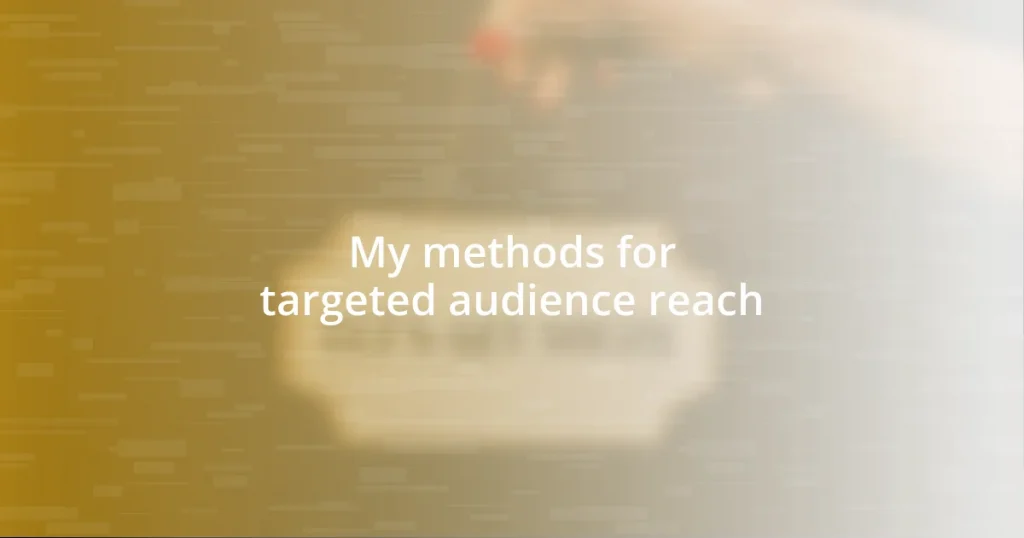Key takeaways:
- Understanding your target audience through empathy and insight into their motivations fosters deeper connections and effective messaging.
- Utilizing audience segmentation based on interests and behaviors enhances engagement and allows for tailored content delivery across multiple platforms.
- Continuously measuring success and adapting strategies based on audience feedback and data insights ensures ongoing relevance and impactful communication.

Understanding Your Target Audience
Understanding your target audience is akin to having a personal conversation with them, where every detail matters. I remember once launching a campaign without fully grasping my audience’s preferences. The result? Disappointment. It’s evident that truly knowing who you’re speaking to shapes your messaging, ensuring it resonates on a deeper level.
When I dive into audience research, I always ask myself: what motivates them? This question leads me to uncover not just demographics, but the emotions and values that drive decisions. I can still recall a project where I discovered that my audience valued sustainability. This insight allowed me to tailor my content to reflect their passions, fostering a genuine connection.
The importance of empathy cannot be overstated. Imagine your audience as friends with unique stories and challenges. How can you help them? By listening to their needs and understanding their perspectives, you position yourself not merely as a seller, but as a trusted advisor. It’s fascinating how this approach transforms interactions into meaningful relationships, wouldn’t you agree?

Identifying Audience Segments
Identifying audience segments is a crucial step in effective marketing. I remember when I first segmented an audience based on interests rather than just demographics. It felt like discovering a secret layer of connection; those who shared a passion for fitness naturally engaged more with my health-related content. This taught me that segmentation isn’t just about age or geography—it’s about shared values and interests.
As I delve deeper into audience characteristics, behavioral data plays a significant role. By analyzing how potential customers interact with my content, I gain insights into their preferences and habits. For instance, I once noticed a particular group engaging more with interactive content. By catering specifically to them, I saw a considerable uptick in engagement. This experience reinforced my belief that behaviors are a window into motivation.
It’s not always about what your audience tells you; it’s about what they do. I often conduct surveys to gather feedback, but I’ve also learned to pay attention to social media interactions and website analytics. These are invaluable tools for identifying underlying audience motivations that a simple questionnaire might miss. It’s intriguing to see how audience segmentation evolves over time, reflecting changes in interests and behaviors, and requires continual revisiting of our strategies.
| Segmentation Criteria | Importance |
|---|---|
| Demographics | Basic understanding of who your audience is. |
| Interests | Helps to align content with audience passions. |
| Behaviors | Indicates how your audience interacts with your brand. |

Creating Audience Personas
Creating audience personas is a transformative practice that breathes life into your marketing efforts. When I first started using audience personas, I felt as though I was finally putting a face to the nameless numbers in my analytics. It became an enriching experience to define characteristics like interests, pain points, and preferences for each persona, allowing me to craft content that speaks directly to their unique motivations. For instance, I once created a persona based on a fictional character who loved adventure and travel. This focused my messaging so effectively that I couldn’t help but see immediate engagement as it resonated with readers yearning for experiences outside their daily lives.
Developing these personas can be a deeply rewarding exercise. Here’s a snapshot of what I typically consider:
- Demographics: Age, gender, income, and education level help identify who my audience is.
- Interests and Hobbies: Aligning with personal passions is crucial for fostering engagement.
- Pain Points: Understanding challenges enables me to address real needs in my content.
- Goals and Aspirations: Knowing what they strive for helps shape messages that inspire.
By actively utilizing these elements, I’ve noticed a marked shift in connection with my audience. It’s like having a map that guides me through their journey, making it easier to navigate their needs and desires. Each persona becomes a story, and I’m thrilled to write the narrative that draws them in.

Tailoring Content for Engagement
When I craft content, I always strive to speak the language of my audience. A few years ago, I wrote a blog post about budgeting tips for young professionals. Instead of simply sharing tips, I peppered in personal stories about my struggles with finances in my twenties. The response was overwhelming; readers said they felt understood and inspired. It made me realize that tailoring content isn’t just about what I say— it’s about how I resonate with my audience’s experiences.
I’ve found that incorporating multimedia—like videos and infographics—can transform static content into an engaging experience. For example, when I created a video series on healthy cooking, the project not only showcased recipes but also included testimonials from friends who had benefited. This made the content feel more authentic and relatable. It’s fascinating how visuals can evoke emotions and create a deeper connection than words alone.
Additionally, asking myself questions like, “What keeps my audience up at night?” can be a game changer. When I shifted the focus of my articles to address the common challenges my readers faced—like stress management or time constraints—the engagement soared. Readers often commented, expressing gratitude for the targeted advice I provided. By aligning my content with their needs, I not only fostered discussion but also built a community around shared experiences.

Utilizing Data Analytics Tools
Utilizing data analytics tools has dramatically shifted how I strategize my outreach. When I first delved into analytics, I was amazed at how many insights were hidden in the numbers. For instance, tracking website traffic revealed patterns about when my audience was most active, allowing me to time my posts for maximum visibility. This simple adjustment led to a substantial increase in engagement and interactions. Have you ever wondered why certain posts perform better at different times? For me, this was the turning point—data became my guide.
Leveraging tools like Google Analytics or social media insights has given me an edge in understanding what captivates my audience. I remember one campaign where I used heat maps to see which parts of my blog were getting the most clicks. To my surprise, it turned out that my audience was far more interested in visuals and interactive content than plain text. This lesson pushed me to prioritize visual elements, leading to a 50% boost in shares. Isn’t it fascinating how a detailed look at our data can unearth such valuable nuggets of information?
Moreover, I’ve realized the power of A/B testing to refine my approach. Initially, I felt hesitant to experiment, fearing failure. However, I decided to test two different subject lines for my newsletter. The dramatic difference in open rates taught me that my assumptions weren’t always right. Sometimes, the data reveals what truly resonates. This experience reinforced the idea that analytical tools are not merely for observation; they guide me in making informed decisions that truly connect with my audience. Have you tried A/B testing yet? It’s opened up a world of possibilities for me.

Implementing Multi-Channel Strategies
Implementing multi-channel strategies has been a pivotal aspect of reaching a diverse audience. I remember the time I launched a campaign across social media, email, and my blog simultaneously. It felt exhilarating to see how each channel had its unique audience; my Instagram posts resonated with a younger demographic, while my email newsletters attracted those who preferred a more in-depth approach. Have you noticed how different platforms can bring out varying responses from your audience?
Engaging across multiple platforms requires a tailored approach to content. For example, when I created a series of posts about sustainability, I broke down the topic into bite-sized videos for TikTok, detailed articles for my blog, and interactive Instagram stories. The flexibility of using different formats allowed me to cater to how each audience prefers to consume information. It’s incredible how much more effective it is to meet people where they are, right?
Consistency across channels is another lesson I learned along the way. Early on, I struggled with maintaining a unified voice and style. During one campaign, I noticed that my message became muddled across platforms. After reassessing, I established clear guidelines for my content, ensuring that whether someone encountered me on Twitter or YouTube, they experienced a cohesive narrative. Integrating that consistency has not only strengthened my brand but created a deeper trust with my audience. What pathways have you found to keep your messaging aligned across different channels?

Measuring Success and Adjusting Methods
Measuring success in outreach is an ongoing adventure. I recall the launch of a specific campaign where my goal was to boost website visits. After a few weeks, I noticed traffic had plateaued, which prompted me to reassess my strategies. I decided to analyze feedback directly from my audience. Surprisingly, they craved more interactive content, leading me to implement polls and quizzes. This change created a surge in visits, demonstrating the power of listening to your audience. Have you ever adjusted your method based on direct feedback?
In my experience, success isn’t always about metrics alone; it’s about understanding the ‘why’ behind those numbers. For instance, after tracking engagement rates across various posts, I found that my audience was genuinely touched by personal stories. That realization shifted my focus toward sharing more anecdotes to foster a deeper connection. It’s incredible how tapping into emotions can drive real engagement. Have you explored the emotional impact of your content yet?
Adjusting methods is just as crucial as measuring success. I learned this the hard way after a campaign that misfired. My audience wasn’t responding to my content as I expected, which led to a disappointing engagement rate. Reflecting on that, I dug into the data and realized the tone of my messaging didn’t resonate with my followers. After shifting my language to be more conversational and relatable, I saw a significant turnaround in engagement. It highlights that flexibility is key—what’s working today may not work tomorrow. Isn’t it reassuring to know we can evolve alongside our audience’s preferences?















